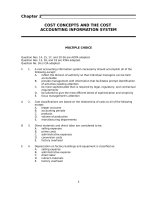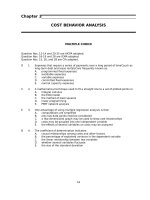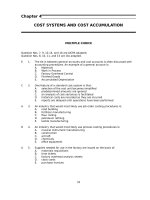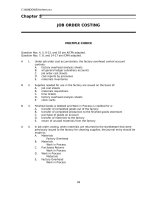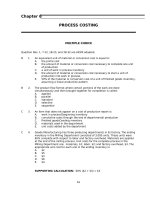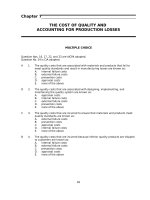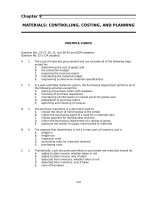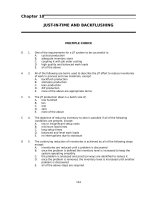Test bank cost accounting 6e by usry 12 factory overhead planned, actual applied
Bạn đang xem bản rút gọn của tài liệu. Xem và tải ngay bản đầy đủ của tài liệu tại đây (85.7 KB, 14 trang )
Chapter 12
FACTORY OVERHEAD: PLANNED, ACTUAL, AND APPLIED
MULTIPLE CHOICE
Question Nos. 8 and 13-15 are AICPA adapted.
Question Nos. 10 and 12 are ICMA adapted.
Question Nos. 9, 11, and 21 are CIA adapted.
E
1.
All of the following phrases are used as alternate terminology for "factory overhead" except:
A.
manufacturing expense
B.
indirect manufacturing cost
C.
factory expense
D.
factory burden
E.
other expense
C
2.
The component of per-unit costs that remains constant as the production level varies is:
A.
general and administrative expenses
B.
commercial expenses
C.
variable factory overhead
D.
fixed factory overhead
E.
heat, light, and power
D
3.
To express factory overhead as a percentage of direct materials dollars, estimated factory
overhead is divided by estimated:
A.
machine hours
B.
normal capacity
C.
units of materials used
D.
materials cost
E.
materials requisition usage
E
4.
Estimated factory overhead is $600,000, and the hours usage of machinery is expected to be
150,000. Factory overhead is applied at the rate of $10 per direct labor hour. The wage rate
for direct labor is $6 per hour, and the total number of estimated direct labor hours for the
period is:
A.
100,000
B.
150,000
C.
300,000
D.
600,000
E.
60,000
160
161
Chapter 12
SUPPORTING CALCULATION:
$600,000
= $10/ DLHR
x
x = 60,000
B
5.
An objection to the use of a factory overhead rate based on direct labor dollars is that:
A.
these items are difficult to measure
B.
a job is charged with more overhead when a highly paid operator works on the job than
when a low-paid operator performs the work
C.
overhead is allocated in relation to units produced by workers
D.
overhead rates will be distributed inequitably when there are no wage differentials in
the department
E.
costs of applying this method are excessive
D
6.
A company expects to produce an average of 75,000 units per year, but last year production
equaled 60,000 units. For the coming year, estimated production is 90,000 units. Estimated
overhead costs are $900,000, and overhead is applied at the rate of $10 per unit. The company
bases its overhead rates on:
A.
theoretical (engineering) capacity
B.
a short-term planning approach
C.
historical capacity costs
D.
expected actual capacity
E.
normal capacity
C
7.
Direct costing differs from absorption costing in that:
A.
direct materials and direct labor do not become a part of product cost under direct
costing
B.
the variable portion of overhead cost does not become a part of product cost under
direct costing
C.
the fixed portion of overhead cost does not become a part of product cost under direct
costing
D.
marketing and administrative expenses become a part of product cost under direct
costing
E.
direct costing does not differ from absorption costing
E
8.
Application rates for factory overhead best reflect anticipated fluctuations in sales over a cycle
of years when they are computed under the concept of:
A.
practical capacity
B.
expected actual capacity
C.
theoretical capacity
D.
maximum capacity
E.
normal capacity
D
9.
Underapplied factory overhead related to a significant decrease in production should be
charged to:
A.
Finished Goods Inventory
B.
Cost of Goods Sold
C.
Work in Process Inventory and Finished Goods Inventory
D.
Work in Process Inventory, Finished Goods Inventory, and Cost of Goods Sold
E.
Work in Process Inventory
Factory Overhead: Planned, Actual, and Applied
B
10.
162
Brownfield Company applies factory overhead on the basis of direct labor hours. Budget and
actual data for direct labor and overhead for the year are as follows:
..........................................................................................................
Direct labor hours....................................................................................
Factory overhead costs...........................................................................
Budget
600,000
$720,000
Actual
550,000
$640,000
The factory overhead for Brownfield for the year is:
A.
underapplied by $40,000
B.
overapplied by $20,000
C.
overapplied by $40,000
D.
underapplied by $20,000
E.
neither underapplied nor overapplied
SUPPORTING CALCULATION:
$720,000
$640,000 •
_ 550,000 = ($20,000)
600,000
D
11.
A company manufactures plastic products for the home and restaurant market. The company
also does contract work for other customers and utilizes a job order costing system. The
flexible budget covering next year's expected range of activity is:
Direct labor hours....................................................
Machine hours..........................................................
Variable overhead costs...........................................
Fixed overhead costs................................................
Total overhead costs.................................................
50,000
40,000
$100,000
150,000
$250,000
80,000
64,000
$160,000
150,000
$310,000
110,000
88,000
$220,000
150,000
$370,000
A predetermined overhead rate based on direct labor hours at expected actual capacity is used
to apply total overhead. Management has estimated that 100,000 direct labor hours will be
used next year. The predetermined overhead rate per direct labor hour to be used to apply total
overhead to individual jobs next year is:
A.
$3.70
B.
$3.88
C.
$3.36
D.
$3.50
E.
none of the above
SUPPORTING CALCULATION:
$310,000 + $2(100,000 - 80,000)
163
Chapter 12
=
C
12.
$350,000
= $3.50
100,000
At the end of the last fiscal year, Tiger Company had the following account balances:
Overapplied Overhead.........................................................................................................
Cost of Goods Sold................................................................................................................
Work in Process Inventory..................................................................................................
Finished Goods Inventory...................................................................................................
$
1,000
980,000
38,000
82,000
The most common treatment of the Overapplied Overhead would be to:
A.
carry it as a deferred credit on the balance sheet
B.
report it as a miscellaneous operating revenue on the income statement
C.
credit it to Cost of Goods Sold
D.
prorate it between Work in Process Inventory and Finished Goods Inventory
E.
prorate it among Work in Process Inventory, Finished Goods Inventory, and Cost of
Goods Sold
A
13.
Overapplied factory overhead would result if:
A.
factory overhead costs incurred were less than costs charged to production
B.
factory overhead costs incurred were unreasonably large in relation to units produced
C.
factory overhead costs incurred were greater than costs charged to production
D.
theoretical capacity were used in computing the overhead rate
E.
the plant were operating at less than normal capacity
D
14.
Clyde Company found that the differences in product costs resulting from the application of
predetermined overhead rates rather than actual overhead rates were very significant when
actual production was substantially less than planned production. The most likely explanation
is that:
A.
costs of overhead were substantially less than anticipated
B.
overhead was composed chiefly of variable costs
C.
several products were produced simultaneously
D.
fixed factory overhead was a significant cost
E.
costs of overhead items were substantially higher than anticipated
A
15.
Avery Co. uses a predetermined factory overhead rate based on direct labor hours. For the
month of October, Avery's budgeted overhead was $300,000 based on a budgeted volume of
100,000 direct labor hours. Actual overhead amounted to $325,000 with actual direct labor
hours totaling 110,000. How much was the overapplied or underapplied overhead?
A.
$5,000 overapplied
B.
$5,000 underapplied
C.
$30,000 overapplied
D.
$30,000 underapplied
E.
none of the above
SUPPORTING CALCULATION:
Factory Overhead: Planned, Actual, and Applied
164
$300,000
(110,000) • $325,000 = $5,000
100,000
A
16.
The absolute maximum capacity possible under the best conceivable operating conditions is a
description of which type of activity level used in the computation of overhead rates?
A.
theoretical
B.
normal
C.
practical
D.
expected actual
E.
currently attainable (expected)
B
17.
All of the following are terms used to describe the phenomenon measured in the denominator
of an overhead rate, except the:
A.
base
B.
overhead cost base
C.
overhead rate base
D.
overhead allocation base
E.
all of the above are acceptable terms
B
18.
The budget for a given factory overhead cost during a given period was $80,000. The actual
cost for the period was $72,000. Considering these facts, it can be said that the plant manager
has done a better-than-expected job in controlling the cost if:
A.
the cost is a discretionary fixed cost and actual production equaled budgeted production
B.
the cost is variable and actual production equaled budgeted production
C.
the cost is variable and actual production was 90% of budgeted production
D.
the cost is fixed and the actual production was less than budgeted production
E.
the cost is variable and actual production was 80% of budgeted production
B
19.
In highly automated manufacturing, all of the following may be appropriate bases for factory
overhead application except:
A.
machine hours
B.
direct labor hours
C.
number of setups
D.
number of inspections
E.
movement of materials
E
20.
The transactions-base approach to overhead application gives particular consideration to:
A.
the amount of direct labor cost
B.
the number of machine hours
C.
overhead costs that are not driven by volume of output
D.
special, high-volume production items
E.
homogeneous production processes
D
21.
When the amount of overapplied factory overhead is significant, the entry to close Overapplied
Factory Overhead will most likely require:
A.
a debit to Cost of Goods Sold
B.
debits to Cost of Goods Sold, Finished Goods Inventory, and Work in Process Inventory
C.
a credit to Cost of Goods Sold
D.
credits to Cost of Goods Sold, Finished Goods Inventory, and Work in Process Inventory
E.
none of the above
165
Chapter 12
A
22.
The type of activity level that results when theoretical capacity is reduced by allowances for
unavoidable interruptions is:
A.
practical capacity
B.
expected actual capacity
C.
normal capacity
D.
excess capacity
E.
none of the above
D
23.
The condition that results either from greater productive capacity than the company could ever
hope to use or from an imbalance in equipment or machinery is termed:
A.
theoretical capacity
B.
practical capacity
C.
idle capacity
D.
excess capacity
E.
none of the above
B
24.
The method of product costing in which only variable overhead is included in the overhead rate
is:
A.
absorption costing
B.
direct costing
C.
conventional costing
D.
full costing
E.
none of the above
C
25.
All of the following are names for the product costing method in which both fixed and variable
costs are included in overhead rates, except:
A.
absorption costing
B.
conventional costing
C.
direct costing
D.
full costing
E.
all of the above
Factory Overhead: Planned, Actual, and Applied
166
PROBLEMS
PROBLEM
1.
Determining Overhead Rate; Expected Actual Capacity Method. Desmond Corp. estimates that its
production for the coming year will be 10,000 widgets, which is 80% of normal capacity, with the following
unit costs: materials, $40; direct labor, $60. Direct labor is paid at the rate of $24 per hour. The widget
shaper, the most expensive piece of machinery, must be run for 20 minutes to produce one widget. Total
estimated overhead is expected to consist of $400,000 for variable overhead and $400,000 for fixed
overhead.
Required: Compute the overhead rate for each of the following bases, using the expected actual capacity
activity level:
(1)physical output
(2)materials cost
(3)direct labor cost
(4)direct labor hours
(5)machine hours
(Round all amounts to the nearest whole number.)
SOLUTION
(1)
(2)
(3)
Estimated overhead (EOH)
$800,000
=
= $80 overhead per widget
Estimated units of production 10,000 widgets
EOH
$800,000
_ 100 =
_ 100 = 200% of materials cost
Estimated materials cost
$40 _ 10,000 widgets
EOH
$800,000
_ 100 =
_ 100 = 133% of direct labor cost
Estimated direct labor cost
$60 _ 10,000 widgets
(4)
EOH
$800,000
=
Estimated direct labor hours 25,000 hours
1
1
= $32 per direct labor hour
Labor cost per widget $60
=
= 2.5 direct labor hours per widget
Labor widget rate
$24
2.5 direct labor hours per widget x 10,000 widgets = 25,000 estimated direct labor hours
167
(5)
Chapter 12
EOH
$800,000
=
Estimated machine hours 3,333 hours
1
1
= $240 per machine hour
20 minutes per widget
= 1 / 3 machine hour per widget
60 minutes per hour
1/3 hour per widget x 10,000 widgets = 3,333 estimated machine hours
NOTE: Since the following problem is identical to Problem 1, except for the activity level used, do not test on
both problems at the same time.
PROBLEM
2.
Determining Overhead Rate; Normal Capacity Method. Desmond Corp. estimates that its production for
the coming year will be 10,000 widgets, which is 80% of normal capacity, with the following unit costs:
materials, $40; direct labor, $60. Direct labor is paid at the rate of $24 per hour. The widget shaper, the
most expensive piece of machinery, must be run for 20 minutes to produce one widget. Total estimated
overhead is expected to consist of $400,000 for variable overhead and $400,000 for fixed overhead.
Required: Compute the overhead rate for each of the following bases, using the normal capacity activity
level:
(1)physical output
(2)materials cost
(3)direct labor cost
(4)direct labor hours
(5)machine hours
(Round answers to the nearest whole dollar or percentage.)
SOLUTION
Factory Overhead: Planned, Actual, and Applied
(1)
$800,000
= $64 overhead per widget
12,500 widgets
$800,000
_ 100 = 160% of materials cost
($40 _ 12,500 widgets)
(2)
(3)
168
$800,000
_ 100 = 107% of direct labor cost
($60 _ 12,500 widgets)
(4)
$800,000
= $25.60 or $26 per direct labor hour
(2.5 hours _ 12,500 widgets)
(5)
$800,000
= $192 per machine hour
(1 / 3 hour _ 12,500 widgets)
PROBLEM
3.
Factory Overhead Application. St. Louis Sounds Inc. manufactures audio equipment. The company
estimates the following costs at normal capacity and other items for the coming period:
Direct materials......................................................................................................
Direct labor.............................................................................................................
Factory overhead (fixed)......................................................................................
Factory overhead (variable)................................................................................
Normal capacity.....................................................................................................
Expected production.............................................................................................
$300,000
520,000
300,000
240,000
100,000 direct labor hours
80,000 direct labor hours
Required: Compute the overhead application rate for fixed, variable, and total overhead per direct labor
hour, using both the normal capacity and the expected actual capacity activity levels.
SOLUTION
Overhead per Direct Labor Hour
Overhead
Fixed.................................................
At Expected
Actual Capacity
$300,000
----------------80,000 DLH
At Normal Capacity
=
$3.75
$300,000
------------------ =
100,000 DLH
$3.00
169
Variable............................................
Total..................................................
Chapter 12
$192,000
----------------80,000 DLH
=
2.40
$6.15
$240,000
------------------ =
100,000 DLH
2.40
$5.40
Factory Overhead: Planned, Actual, and Applied
170
PROBLEM
4.
Overhead Analysis. Data for the past two years for J&J Corp. are:
19A
Units produced.................................................................................................................
10,000
Overhead applied per unit............................................................................................. $
15
Actual overhead:
Fixed............................................................................................................................
50,000
Variable.......................................................................................................................
95,000
Estimated overhead:
Fixed............................................................................................................................
50,000
Variable.......................................................................................................................
130,000
$
19B
11,000
18
55,000
150,000
56,000
142,000
The company determines overhead rates based on estimated units to be produced.
Required:
(1)
(2)
Determine the estimated units of production used to obtain the overhead allocation rates in 19A
and 19B.
Determine the over- or underapplied factory overhead for each of the two years.
SOLUTION
171
Chapter 12
(1)
Estimated overhead
= Overhead per unit
Estimated units of production
19A:
$50,000 + $130,000
= $15
x
$15 x = $180,000
x = 12,000 Estimated units of production
19B:
$56,000 + $142,000
= $18
x
$18 x = $198,000
x = 11,000 Estimated units of production
(2)
19A:
19B:
Applied Factory Overhead (10,000 x $15)...........................................................................
Actual Factory Overhead........................................................................................................
Overapplied Factory Overhead.............................................................................................
$
Actual Factory Overhead........................................................................................................
Applied Factory Overhead (11,000 x $18)............................................................................
Underapplied Factory Overhead...........................................................................................
$
$
$
150,000
145,000
5,000
205,000
198,000
7,000
Factory Overhead: Planned, Actual, and Applied
172
PROBLEM
5.
Entries for Factory Overhead. Blend Rite Inc. assembles and sells electric mixers. All parts are purchased
and labor is paid on the basis of $22 per mixer assembled. The cost of the parts per mixer totals $20. As
the company handles only this one product, the unit cost basis for applying factory overhead is used.
Estimated factory overhead for the coming period, based on a production of 40,000 mixers, is as follows:
Indirect materials....................................................................................................................................
Indirect labor...........................................................................................................................................
Light and power......................................................................................................................................
Depreciation.............................................................................................................................................
Miscellaneous...........................................................................................................................................
$
60,000
180,000
45,000
35,000
16,000
During the period, 42,000 mixers were assembled and actual factory overhead was $355,000. These units
were completed but not yet transferred to the finished goods storeroom.
Required:
(1)
(2)
Prepare journal entries to record the above information, including the entry to close the balance in
the applied overhead account to the actual overhead account.
Determine the amount of over- or underapplied factory overhead.
SOLUTION
(1)
Work in Process...............................................................................................
Materials....................................................................................................
840,000
Work in Process...............................................................................................
Payroll........................................................................................................
924,000
Factory Overhead Control............................................................................
Materials, Payroll, Accruals, and Various Credits............................
355,000
Work in Process...............................................................................................
Factory Overhead Applied....................................................................
352,800
Factory Overhead Applied............................................................................
Factory Overhead Control.....................................................................
352,800
Overhead rate :
(2)
840,000
924,000
355,000
352,800
352,800
Estimated factory overhead $336,000
=
= $8.40 factory overhead rate per mixer
Estimated production
40,000
Underapplied factory overhead: $355,000 - $352,800 = $2,200
173
Chapter 12
PROBLEM
6.
Disposition of Over- or Underapplied Overhead. The following information is available concerning the
inventory and cost of goods sold accounts of PGA Company at the end of the most recent year:
Direct material..............................................................................
Direct labor...................................................................................
Applied overhead.........................................................................
Year-end balance..........................................................................
Work in
Process
$ 5,000
6,000
4,000
$ 15,000
Finished
Goods
$ 8,000
15,000
12,000
$ 35,000
Cost of Goods
Sold
$ 11,000
15,000
24,000
$ 50,000
Applied overhead has already been closed to Factory Overhead Control.
Required:
Give the journal entry required to close Factory Overhead Control, assuming:
(1)
Overapplied overhead of $10,000 is to be allocated to inventories and Cost of Goods Sold in
proportion to the balances in those accounts.
(2)
Underapplied overhead of $10,000 is to be allocated to inventories and Cost of Goods Sold in
proportion to the amounts of applied overhead contained in those accounts.
SOLUTION
Requirement (1)
Account
Percentage of
Balance
Total
Work in Process............................................. $
15,000
15%
Finished Goods..............................................
35,000
35%
Cost of Goods Sold.......................................
50,000
50%
Total.......................................................... $ 100,000
100%
(1)
(2)
Requirement (2)
Applied
Percentage of
Overhead
Total
$
4,000
10%
12,000
30%
24,000
60%
$ 40,000
100%
Factory Overhead Control..............................................................................
Work in Process.........................................................................................
Finished Goods..........................................................................................
Cost of Goods Sold...................................................................................
10,000
Work in Process.................................................................................................
Finished Goods..................................................................................................
Cost of Goods Sold...........................................................................................
Factory Overhead Control......................................................................
1,000
3,000
6,000
1,500
3,500
5,000
10,000

